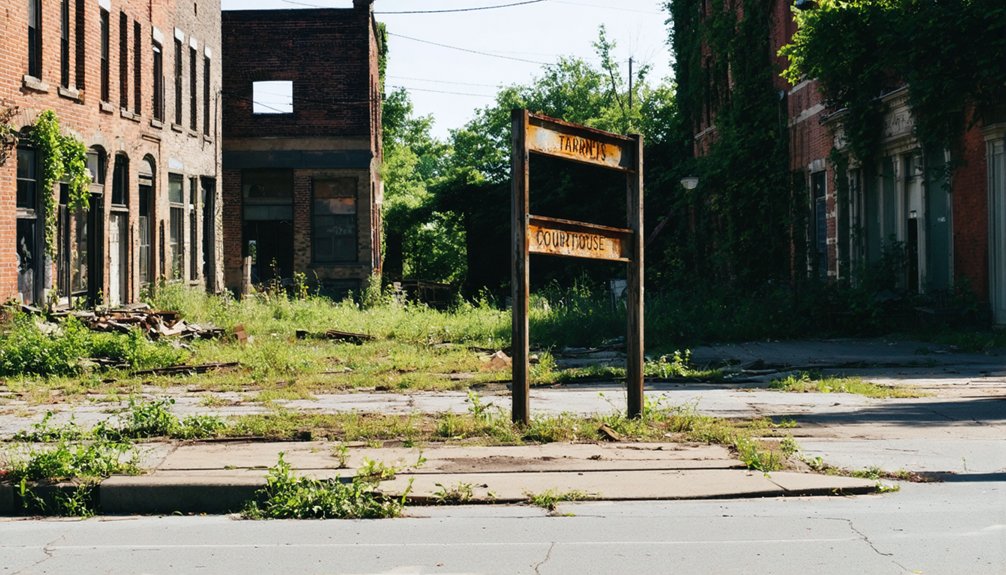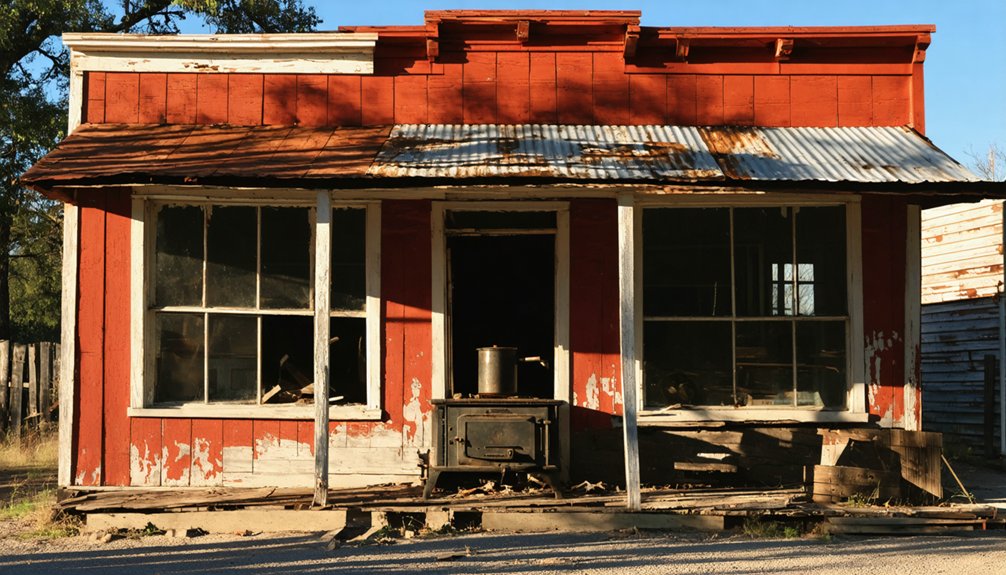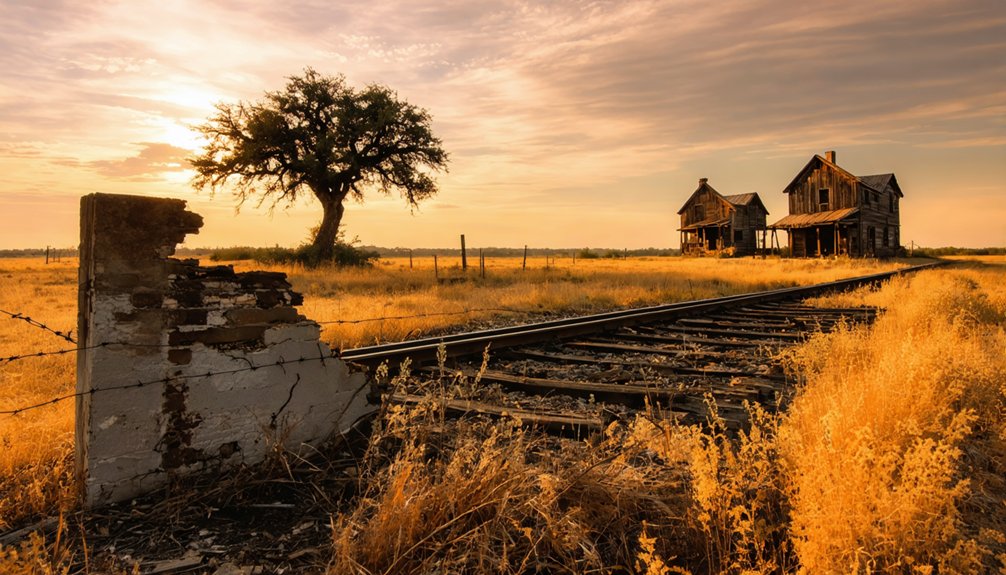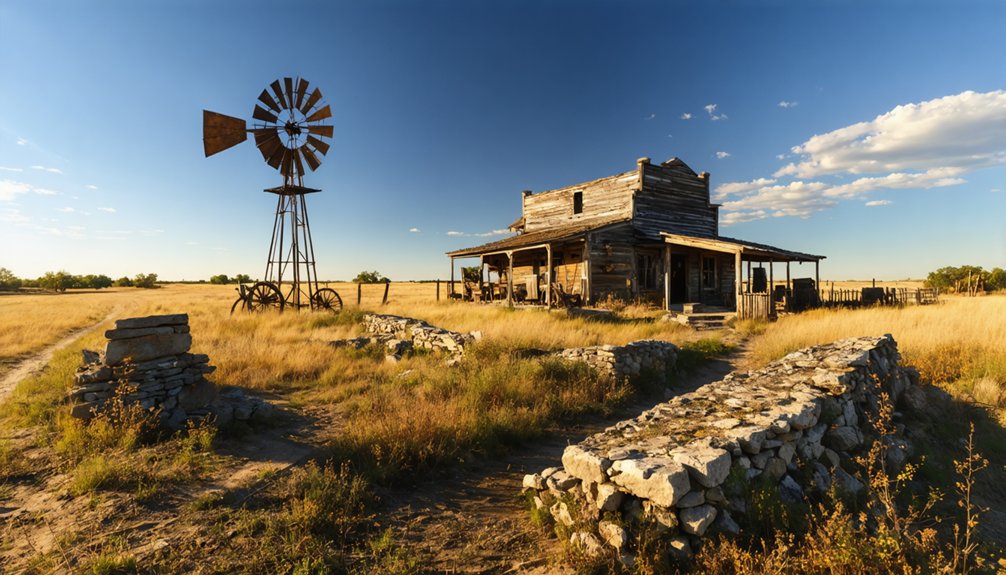You’ll find Old Tarrant’s remnants in Hopkins County, Texas, where it once served as the county’s first seat of government in the mid-1800s. The town thrived with over 5,000 residents, boasting a courthouse, post office, and tannery until 1870, when officials relocated county records to Sulphur Springs. Without its administrative function and railway access, the settlement quickly declined into a ghost town. Today, only a cemetery and church remain to tell its frontier tale.
Key Takeaways
- Tarrant was Hopkins County’s first county seat, established in the mid-1800s with a thriving population of over 5,000 by 1860.
- The town declined after losing its county seat status to Sulphur Springs in 1871, leading to business closures and population exodus.
- Poor transportation infrastructure and lack of railway access contributed to Tarrant’s transformation into a ghost town.
- A state historical marker placed in 1975 commemorates the former town’s significance in early Texas settlement history.
- Only the cemetery and church remain as preserved landmarks of the once-bustling community named after General Edward H. Tarrant.
The Rise and Fall of a County Seat
When Old Tarrant became Hopkins County’s first county seat in the mid-19th century, it quickly established itself as a regional hub of commerce and governance.
Five creeks converged at Tarrant’s location, providing rich soil and abundant game for early settlers.
You’d have found a bustling post office, tannery, and various businesses contributing to Tarrant’s economy, while the courthouse served as the center of local political life.
The town’s prominence wouldn’t last long, though. By 1870, county records were forcibly relocated to Sulphur Springs, and legislation made the move official in 1871.
Despite its early success, Old Tarrant’s power crumbled when county records were forcibly moved to Sulphur Springs in 1870.
Similar to the Trinity River tributaries that shaped Tarrant County’s landscape, water played a crucial role in the town’s early development.
Unlike other Texas towns that faced county rivalries and survived, Tarrant couldn’t overcome this devastating loss. The courthouse was dismantled, businesses shuttered, and residents began moving away.
Without its administrative function and hampered by poor roads and lack of railway access, Tarrant faded into obscurity.
Legacy of General Edward H. Tarrant
While the ghost town of Tarrant has faded into history, you’ll find its namesake, General Edward H. Tarrant, left an indelible mark on North Texas through his military leadership and frontier diplomacy.
Born in South Carolina, Tarrant grew up to become a distinguished military and political figure who shaped the Texas frontier.
Before making his mark in Texas, Tarrant had established himself as a respected leader, serving as chief justice of Red River County.
As a veteran of the War of 1812 who later commanded Texas militia forces, Tarrant’s campaigns against Native Americans and negotiation of the 1843 Treaty of Bird’s Fort helped secure the region for settlement.
You can trace his lasting influence in the naming of Tarrant County and Fort Worth’s development as its seat, reflecting his essential role in early Texas frontier expansion.
Military Leadership and Impact
Throughout the Republic of Texas era, Brigadier General Edward H. Tarrant shaped military tactics and frontier defense through decisive leadership. You’ll find his influence most evident in his command of the Fourth Brigade militia unit from northeast Texas, where he orchestrated swift campaigns against threats to Anglo settlements. He served as County Sheriff in Tennessee before coming to Texas.
As a former Tennessee militia colonel with War of 1812 experience, Tarrant brought valuable expertise to Texas’s emerging defense structure. He’d shift from the Texas Congress to lead the Northwest Frontier Rangers in 1837, demonstrating his commitment to settlers’ protection. His participation in the Battle of New Orleans in 1815 had prepared him well for frontier warfare.
His military prowess peaked during the 1841 Battle of Village Creek, where he commanded militia forces in a significant engagement. Later, he’d prove instrumental in negotiating the 1843 Treaty of Bird’s Fort, balancing combat leadership with diplomatic skills to secure frontier territories.
Early Texas Settlement Role
As a pivotal figure in early Texas settlement, General Edward H. Tarrant received his land grant in 1838 as a head of household, joining other early settlers like the Daggetts and Yorks in shaping north-central Texas.
You’ll find his influence deeply woven into the region’s transformation, as he balanced roles of landowner, military leader, and politician.
Through complex native relations, including the 1843 Treaty of Bird’s Fort, Tarrant’s actions directly impacted the area’s development.
While serving as Chief Justice of Red River County and in the Texas House of Representatives, he helped establish the framework for settler communities. His early experience as sheriff of Henry County in Tennessee prepared him for his future leadership roles in Texas.
His military campaigns along Village Creek opened vast territories for settlement, fundamentally altering the landscape and enabling the establishment of what would become Fort Worth and the county bearing his name.
Namesake Town’s Lasting Honor
The legacy of General Edward H. Tarrant lives on through the town that once bore his name and the thriving county that still does.
You’ll find his historical significance deeply woven into Texas’s frontier narrative, from his decisive military leadership to his diplomatic efforts with Native American tribes. As a brigadier-general who commanded militia units and negotiated the Treaty of Bird’s Fort in 1843, Tarrant’s influence shaped the region’s development.
His service as a chief justice of Red River County further demonstrated his commitment to law and order in the developing territory.
His dual role as both warrior and statesman is commemorated in various ways – from his final resting place in Pioneer’s Rest Cemetery, Fort Worth, to the county records that document his service.
Though the town of Tarrant is now a ghost town, his impact on Texas history remains indelibly marked on the landscape.
Life Before the Abandonment
Life in Tarrant County during the mid-1800s emerged from humble frontier beginnings, with settlers arriving largely without capital and relying on the land’s natural resources. You’d have witnessed the pioneer challenges of establishing homes, schools, and churches through cooperative community efforts, all while facing treacherous roads and limited transportation options.
Despite these obstacles, the settlement’s civic ambitions drove impressive population growth, expanding from just 599 White residents in 1850 to over 5,000 by 1860.
You’d have found a tight-knit community centered around their church and cemetery, engaging in farming and resource extraction typical of frontier life. The area’s importance was highlighted by the oldest log courthouse which served as a symbol of local governance. However, the lack of major thoroughfares and the absence of railroad connections ultimately hindered Tarrant’s ability to compete with neighboring towns, foreshadowing its eventual decline. The community’s economic stability was further threatened when miners received their wages through a restrictive once-a-month paycheck system.
The Critical Loss of the Courthouse

You’ll find the story of Tarrant’s decline begins with the contentious 1870 transfer of political power to Sulphur Springs, which sparked outrage among local citizens.
The courthouse’s physical dismantling left scattered materials that you can still spot today in buildings along Connally Street.
Your understanding of this critical moment deepens when you consider how the courthouse’s removal stripped Tarrant of its administrative authority, setting the stage for its transformation into a ghost town.
Political Power Shift
During 1870, Tarrant’s political fortunes took a devastating turn when county officials transferred all records from its courthouse to Sulphur Springs, igniting fierce local opposition.
You can trace the shift in political dynamics through the Texas legislature’s 1871 decision to officially designate Sulphur Springs as Hopkins County’s seat of power.
The courthouse significance became painfully clear as Tarrant’s administrative center was sold by the sheriff and dismantled piece by piece.
Without this symbol of county authority, you’d have witnessed Tarrant’s rapid decline into obscurity. The loss stripped the town of its governmental functions and regional influence, while Sulphur Springs flourished.
Despite dangerous, rough roads between the two locations, officials deemed Sulphur Springs more suitable for county administration, sealing Tarrant’s fate.
Scattered Building Materials
The dismantling of Tarrant’s courthouse marked a poignant chapter in the town’s architectural legacy, as locals salvaged and repurposed its materials throughout the county.
You’ll find these remnants of architectural significance carefully integrated into buildings along Connally Street, where they continue to serve practical purposes while preserving a piece of local history.
The materials preservation efforts showcase your community’s resourceful spirit and determination to maintain connections with the past.
These historical building elements tell a story of resilience and adaptation:
- Original courthouse lumber repurposed in local structures
- Building materials integrated into active county buildings
- Architectural features preserved through community initiative
- Historical elements maintaining cultural continuity along Connally Street
These scattered pieces stand as silent witnesses to Tarrant’s legacy, reminding you of the town’s former prominence.
Geographic Isolation’s Role
While many factors contributed to Tarrant’s decline, geographic isolation played a decisive role in its transformation into a ghost town.
You’ll find that significant geographic barriers, including Eagle Mountain Lake and rough terrain, severely limited the town’s connectivity to major transport routes. When the Texas and Pacific Railway bypassed the settlement in the 1890s, the isolation impacts became devastating.
The absence of reliable transportation infrastructure sealed Tarrant’s fate.
You couldn’t easily reach the town due to dangerous, poorly maintained roads, which discouraged trade and new settlers. This physical separation from economic opportunities forced many residents to relocate near railway hubs.
As the population dwindled, essential services disappeared, and the town’s remaining inhabitants had to rely primarily on local resources for survival.
Preserving Historical Landmarks

Despite Tarrant’s decline, local preservation efforts have guaranteed its historical legacy endures through careful maintenance of key landmarks.
Community involvement remains at the heart of historical preservation initiatives, with residents actively participating in protecting what remains of this once-thriving county seat.
You’ll find several preservation achievements that showcase the community’s dedication:
- A state historical marker, granted in 1975, commemorates Tarrant’s significance as Hopkins County’s original seat
- Local volunteers maintain the cemetery and church grounds, preserving these essential historical sites
- Detailed historical documentation by scholars like June Tuck and P.T. Hare guarantees Tarrant’s story lives on
- Regular community-led maintenance projects protect remaining structures from deterioration
Though infrastructure challenges persist, these preservation efforts keep Tarrant’s heritage alive for future generations to discover and appreciate.
Cemetery and Church: Standing Witnesses
Standing as silent sentinels to Tarrant’s past, the cemetery and church remain essential historical landmarks that offer glimpses into pioneer life.
You’ll find cemetery symbolism etched in handmade stones and iron fencing, telling stories of early settlers like A.M. Newton, who was laid to rest in 1857. The church architecture evolved from simple log meetinghouses to frame structures, as seen in Minters Chapel’s 1882 transformation.
While modern development surrounds these sacred spaces, you can still witness the original features preserved through local preservation efforts.
The cemetery’s layout and epitaphs reveal patterns of pioneer hardship, while churches continue serving communities through records and gatherings.
Though ghost towns have vanished, these landmarks stand protected, often marked by Texas Historical plaques and maintained by dedicated caretakers.
Neighboring Ghost Towns’ Stories

You’ll notice a pattern among neighboring ghost towns where transportation shifts, particularly new railroad routes, dramatically altered their fates just as they did in Tarrant.
Like its neighbors Dido and Drop, Tarrant’s church and cemetery remain as essential heritage markers that tell the story of early Texas settlements.
These sacred spaces, preserved across multiple ghost towns in the region, serve as significant links to understanding how transportation changes in the late 1800s reshaped the area’s communities.
Regional Transportation Impacts
When railroads arrived in Tarrant County during the late 1870s, they created a stark divide between towns that flourished and those that faded into obscurity.
You’ll see how transportation evolution fundamentally reshaped the region’s economic shifts, determining which communities would survive and which would vanish.
The impact of changing transportation networks on local towns was profound:
- Rail lines accelerated agricultural growth by connecting farmers to wider markets
- Towns without rail stops often relocated entirely to maintain their economic viability
- The shift from railways to highways concentrated growth in urban centers
- Communities relying on single industries tied to transportation routes faced collapse when networks changed
Fort Worth’s emergence as a major transportation hub with modern infrastructure sealed the fate of smaller, isolated communities like Tarrant that couldn’t adapt to changing times.
Church-Cemetery Heritage Connections
Throughout Tarrant County’s ghost towns, churches and cemeteries serve as enduring links to pioneer communities, with Miners Chapel standing as a prime example since its 1850s establishment.
You’ll find similar church-cemetery connections in neighboring ghost towns like Tarrant, Dido, and Stony, where cemetery preservation efforts maintain essential ties to the region’s heritage. These sacred grounds tell compelling stories through their weathered headstones, with Miners Chapel’s earliest grave dating to 1857.
As you explore these historical sites, you’ll discover how church significance extends beyond religious worship. Local communities actively preserve these landmarks through events like Dido Days, ensuring their cultural legacy endures.
Since achieving Texas Historic Landmark status in 1979, these sites continue attracting visitors while documenting the area’s pioneering spirit.
Community Spirit Through the Ages
Despite its eventual decline into a ghost town, Tarrant’s early community spirit flourished through the cooperation of diverse settlers who arrived in the 1840s and 1850s.
You’ll find evidence of their community resilience in the way they worked together, pooling their limited resources to build essential infrastructure and maintain cultural continuity.
The heart of Tarrant’s community life centered around these crucial elements:
- Churches that served as both spiritual centers and social gathering spaces
- Cooperative farming efforts that sustained the growing population
- Regular community gatherings for construction of schools and public buildings
- Strong bonds formed through women’s organizations and social clubs
Even as transportation shifts and economic changes led to Tarrant’s decline, descendants continue preserving their heritage through cemetery maintenance and historical preservation efforts.
Historical Recognition and Documentation

The preservation of Tarrant’s legacy extends far beyond the community spirit that once defined it.
You’ll find extensive documentation efforts through the dedicated work of local historians like P.T. Hare and June Tuck, who’ve carefully chronicled the town’s historical significance. The 1975 installation of a state historical marker stands as evidence to local historians’ determination to secure recognition for this pioneering settlement.
Today, you can explore the town’s rich history through local archives and historical societies that maintain essential records and artifacts.
The community’s commitment to preservation continues through active maintenance of the Old Tarrant cemetery and church sites.
While the town itself may have faded, its documented legacy serves as a valuable educational resource, offering insights into early Texas settlement life.
Frequently Asked Questions
What Happened to the Original Town Records After the Courthouse Was Moved?
You won’t find much clarity about lost documents after the courthouse relocation, as Tarrant itself never had a courthouse, and records were primarily maintained at the county level elsewhere.
Are There Any Descendants of Original Tarrant Residents Still Living Nearby?
You’ll find it challenging to verify descendant stories, as historical records are limited. While family histories suggest some descendants may live in Hopkins County, there’s no definitive documentation of their presence.
What Native American Tribes Originally Inhabited the Area Before Tarrant’s Establishment?
Like ancient footprints in time’s shifting sands, you’ll find the Hasinai Caddo and Tonkawa were first, followed by Comanche, Kiowa, and Wichita tribes—each leaving their cultural marks on these lands.
Were There Any Notable Crimes or Lawless Incidents in Tarrant’s History?
You won’t find any documented unsolved mysteries or outlaw tales here – historical records show no notable crimes or town legends of lawlessness during Tarrant’s existence before becoming a ghost town.
Did Any Famous Historical Figures Ever Visit or Stay in Tarrant?
Beyond General Edward H. Tarrant himself, you won’t find records of famous visitors to this frontier settlement. Its brief prominence and quick decline limited its historical significance to mostly local pioneers.
References
- https://frontporchnewstexas.com/2022/04/14/history-of-the-old-tarrant-historical-marker/
- https://en.wikipedia.org/wiki/Dido
- https://candysdirt.com/2019/10/06/haltom-citys-ghost-town-roots-help-round-out-this-featured-suburb-sunday/
- https://en.wikipedia.org/wiki/List_of_ghost_towns_in_Texas
- https://dfwurbanwildlife.com/2011/05/29/chris-jacksons-dfw-urban-wildlife/march-28-2005-ghost-towns-in-north-texas/
- https://www.dfwi.org/item/its-a-ghost-town-today-but-heres-why-butler-place-is-viewed-as-a-gem-for-fort-worth
- https://www.texasescapes.com/CentralTexasTownsNorth/Tarrant-Texas.htm
- https://www.tshaonline.org/handbook/entries/tarrant-tx-hopkins-county
- https://www.texasescapes.com/TexasGhostTowns/DidoTexas/DidoTexas.htm
- https://www.tarrantcountytx.gov/en/county/about-tarrant/history.html



